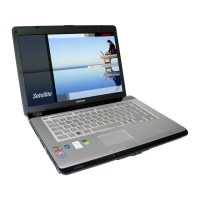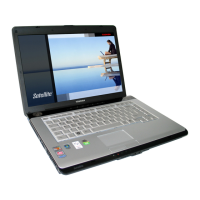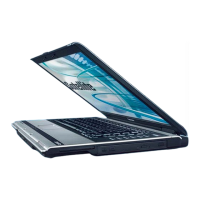
Do you have a question about the Toshiba Satellite A210 and is the answer not in the manual?
| Weight | 2.7 kg |
|---|---|
| Processor | Intel Core 2 Duo |
| RAM | Up to 4GB DDR2 |
| Display | 15.4" WXGA |
| Graphics | Intel GMA X3100 |
| Operating System | Windows Vista |
| Optical Drive | DVD SuperMulti |
| Battery | Lithium-ion |
| Chipset | Intel GM965 |
| Wireless | 802.11a/b/g |
| LAN | 10/100 Ethernet |
| Ports | USB 2.0, VGA, Headphone, Microphone, RJ-45 |
| Card Reader | 5-in-1 |
Lists included items and provides an overview of the computer's hardware components.
Covers pre-installed software and unique features like Hot Keys and power saving.
Details various ports, slots, and memory expansion capabilities of the computer.
Identifies and describes external components on the front, sides, and underside of the computer.
Explains the function of AV buttons, system indicators, and keyboard indicators.
Guides on connecting power, opening the display, and turning the computer on for the first time.
Covers Hibernation, Sleep modes, and restarting the computer.
Explains how to access system recovery and create recovery discs.
Explains touch pad control and fingerprint sensor enrollment/usage for security.
Details operations for optical drives and using the HD DVD Player software.
Explains modem operations, region settings, and Wireless LAN/Bluetooth features.
Details LAN connection and procedures for cleaning and heat dispersal.
Explains basic key types and the functionality of F1-F12 keys.
Details how to use FN key combinations for system control and special features.
Covers zoom, FN sticky key, Windows keys, keypad overlay, and mode switching.
Explains power indicators, battery types, safety, charging, monitoring, and replacement.
Provides tips to extend battery life and how data is retained when power is off.
Explains password protection and power-up modes like Sleep, Hibernation, and Auto Off.
Guides users on accessing and configuring hardware settings via the HW Setup utility.
Details CPU modes, boot priority, and keyboard/USB/LAN settings.
Details installation/removal of Express Cards, memory cards, and memory expansion.
Covers optional power devices, USB FDD Kit, and connecting external monitors, TVs, HDMI, and i.LINK devices.
Outlines guidelines for identifying and resolving computer problems, including initial checks.
Addresses issues with AC adaptor, battery, optical drives, and media compatibility.
Solves problems with keyboard, LCD, touch pad, fingerprint sensor, USB, Modem, LAN, Wireless LAN, Bluetooth, and i.LINK.
Explains factors affecting CPU, memory, battery, HDD capacity, and LCD performance.
Covers transmission speed, icons, copy protection, and LCD brightness for eye comfort.
Summarizes the computer's technical specifications, including dimensions, environmental, and power requirements.
Details the display controller capabilities and supported video modes.
Explains the V.90/V.92 modem technology, transmission speeds, and AT commands.
Provides card specifications and radio characteristics for Wireless LAN.
Details the specifications and plug shapes for AC power cords and connectors.











